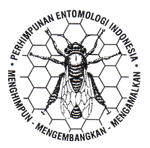Efisiensi pemarasitan parasitoid Trichogramma chilotraeae nagaraja & nagarkatti (Hymenoptera:Trichogrammatidae) pada berbagai jumlah inang dan kepadatan parasitoid.
DOI:
https://doi.org/10.5994/jei.4.2.60Keywords:
Trichogramma chilotraeae, number of host, parasitoid density, parasitis efficiencyAbstract
The objective of the research was to study behaviour and parasitism efficiency of the egg parasitoid Trichogramma chilotraeae in relation to host and parasitoid density under laboratory condition. Eggs of Corcyra cephalonica were used as hosts for Trichogramma chilotraeae. Five different host (egg) densities: 3, 6, 12, 24 and 48 eggs were provided to one and two active female parasitoids T. chilotraeae. Percentage of parasitism, female progeny, and selfsuperparasitism were counted. Results showed that, host density was found to have a strong effect on parasitism rate, female progeny and selfsuperparasitism. Two parameters, parasitism and selfsuperparasitism decreases with increasing number of host density, in contrast, female progeny increase with increasing host density. Parasitoid density affected selfsuperparasitism and female progeny only on one level of host density (3 hosts) but not to all parameters of other density treatments.Downloads
Download data is not yet available.
Downloads
Published
2017-02-23
How to Cite
Hasriyanty, H., Buchori, D., & Pudjianto, P. (2017). Efisiensi pemarasitan parasitoid Trichogramma chilotraeae nagaraja & nagarkatti (Hymenoptera:Trichogrammatidae) pada berbagai jumlah inang dan kepadatan parasitoid. Jurnal Entomologi Indonesia, 4(2), 60. https://doi.org/10.5994/jei.4.2.60
Issue
Section
Articles
License
Authors who publish with this journal agree to the following terms:
- Authors retain copyright and grant the journal right of first publication with the work simultaneously licensed under a Creative Commons Attribution 4.0 International License that allows others to share the work with an acknowledgement of the work's authorship and initial publication in this journal.
- Authors are able to enter into separate, additional contractual arrangements for the non-exclusive distribution of the journal's published version of the work (e.g., post it to an institutional repository or publish it in a book), with an acknowledgement of its initial publication in this journal.
- Authors are permitted and encouraged to post their work online (e.g., in institutional repositories or on their website) prior to and during the submission process, as it can lead to productive exchanges, as well as earlier and greater citation of published work (See The Effect of Open Access).








